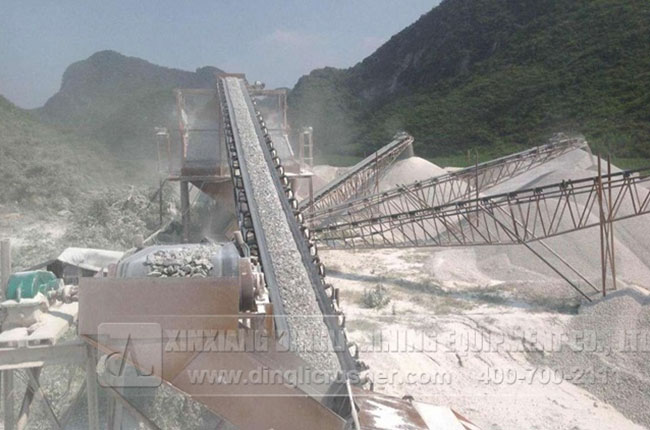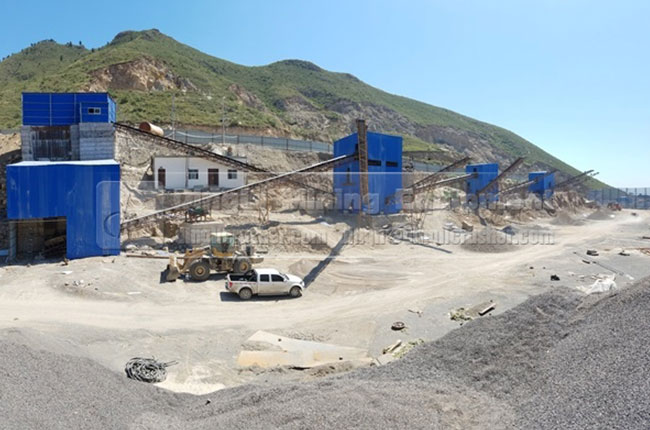 Sand Aggregate IndustryComprehensive Service Provider
Sand Aggregate IndustryComprehensive Service Provider Sand Aggregate IndustryComprehensive Service Provider
Sand Aggregate IndustryComprehensive Service Provider| Model | XJS300 | ||||
| Crushing Chamber Type | Extra Coarse (BC) | Coarse (C) | Medium (M) | Fine (F) | Extra Fine (EF) |
| Standard Type Feeding Hole Size (mm) | 230 | 210 | 150 | 105 | |
| Standard Type Minimum Discharging Hole Size (mm) | 25 | 20 | 15 | 10 | |
| Short Head Feeding Hole Size (mm) | 75 | 54 | 20 | 20 | |
| Short Head Minimum Discharging Size (mm) | 10 | 8 | 6 | 6 | |
| Power (kW) | 180 - 250 | ||||
| Production Capacity (t/h) | 110 - 440 | ||||
*Note: The processing capacity of the XJS300 cone crusher may vary with different materials and feeding sizes.

The owner of this production line has over 20 years of experience in the construction of stone plan. By compared with many others it selects Dingli’s equipment since the aggregates produced have sound grain shape better quality.

Seen from the pics the whole stone crushing line adopts fully-closed mode. Compared with previously open-pit operation it is more eco-friendly. The feed silo production process and discharge silo are also enclosed by the closing plate to

Our large-capacity hammer crusher can hold the stone material with maximum size of 2m. No secondary crusher is configured for the production of final products which greatly simplifies the process.
Application Scenarios: In the initial stage of mining, the ultra-coarse (BC) cavity type plays a crucial role. For example, in the mining of large open-pit coal or iron mines, the huge ore blocks freshly extracted from the mine pits need to be initially crushed for subsequent transportation and further processing. Its feed opening size of 230mm can easily accommodate these large ore blocks, with a maximum feed size of 25mm, allowing the large ore to enter the crusher smoothly.
Production Advantages: This cavity type has a relatively strong production capacity, with an hourly output ranging from 180 to 250 tons and a power range of 110 to 440kw. It can quickly crush a large amount of large ore blocks into smaller sizes, providing raw materials with appropriate particle sizes for subsequent coarse or medium crushing processes, effectively improving the overall efficiency of mining operations.
Application Scenarios: The coarse (C) cavity type is widely used in construction stone processing and secondary crushing in mines. For instance, in a construction stone factory, when the raw material is large blocks of granite or limestone, the stone that has undergone ultra-coarse crushing can be further crushed by the coarse (C) cavity type. In mines, it can serve as a secondary crushing device to reprocess the ore that has been initially crushed.
Production Advantages: Its feed opening size is 210mm, the maximum feed size is 20mm, and the minimum discharge opening is 10mm, which can crush the stone or ore to a particle size of around 75mm. The relatively large particle size of this product can be used as coarse aggregate for building foundations, road bases, etc., and the crushing capacity and production efficiency of this cavity type can meet the demands of large-scale production.
Application Scenarios: In the production of concrete aggregate and fine processing of building materials, the medium (M) cavity type is an important equipment. During the production of concrete aggregate, it can crush various rock raw materials into appropriate particle sizes for preparing high-performance concrete. For the fine processing of building materials, such as the production of artificial stone, it can also provide raw materials with suitable particle sizes.
Production Advantages: The feed opening size is 150mm, the maximum feed size is 15mm, and the minimum discharge opening
We are present worldwide and always here to help.
Get in touch today!